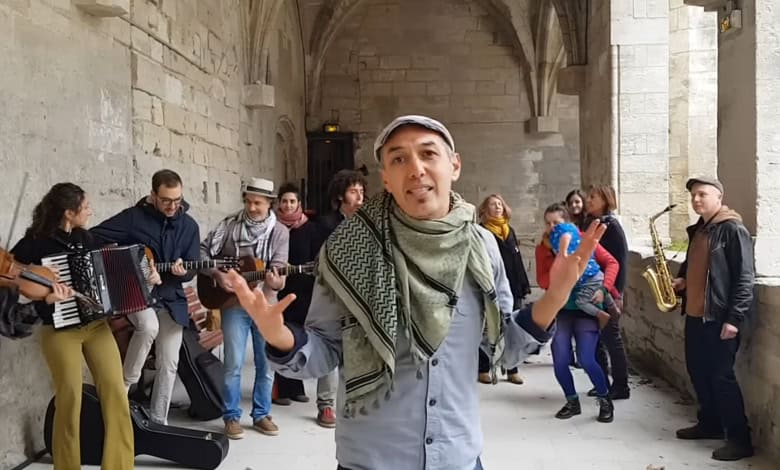The Rebel Song That Defied Pandemic Mania
Looking back at 'Danser Encore' and its anti-authoritarian message

“Danser Encore” was a countercultural phenomenon ignored by American media.
In 2020, songwriter and performer Khadour Hadadi was set to start a concert for a crowd of eager, healthy ticket-holders. He suddenly learned that the venue, under the pressure of emergency declarations, had abruptly canceled the show.
KH, as he is known, got the idea to strike back artistically against those who had–unnecessarily, per scientific analyses–ended his tour.
A year into the oppressive social distancing mandates in Europe and the U.S., , many parts of the U.S., and beyond, KH penned a song called “Danser Encore” (pronounced “Don-say On-core”). The tune, with calypso and jazzy flourishes, struck a chord and inspired viral flashmobs for much-needed social connection.
This group first met on March 4, 2021 at the Gare du Nord (North Train Station) in Paris. The movement spread fast, both on the Internet and in parks and public stations.
Dancing and singing together watered the human spirit like rain in a desert. It rekindled bravery, freedom and camaraderie in defiance of constrictive overreach.
French by nationality, the impact of KH’s “Danser Encore” would be first and strongest felt in Western Europe, and move east to Central and Eastern Europe, and even Asia. “Danser Encore” was spontaneously translated into many languages, and flashmob dances, sans masks, occurred quickly across Spain, Italy, Portugal, Germany, Holland, Belgium, Luxembourg, Austria, Switzerland, Poland, Russia, Greece, Ireland, England, Korea and more by July of that year.
Old-world countries often have infrastructures built for foot traffic, laid long before automobiles. This frequently allows for robust, in-person socializing, and could be one of the reasons tyrannical lockdown-loving Democrats have picked up the mantle of outward sprawl.
What bustling streets and cafe culture mean is that Europeans and others find the act of group dancing in public more second-nature than modern Americans. And so, it was Europeans who felt a yearning for “Danser Encore.”
Specifically, they thirsted for what it offered to their sense of being and belonging, And boy, did they pick up the mug and drink.
They not only met up, danced maskless, and posted their videos, but they interpreted “Danser Encore” to other forms of expressive art. The tune became a line dance, piano arrangements (here, here, here and here), an instructional guitar video, an acrobatic horseback version, a flute performance, an Arab-inspired version, a melancholic ballad, a harp ensemble, a duet, and an accordion solo.
In our hemisphere, “Danser Encore” did come to eastern and western Canada. Argentina, Peru, Haiti, and Mexico got down with “Danser Encore” by July, too.
It later arrived in America. Yours truly was alerted to it and participated in the summer of 2021, and I was hardly alone.
YouTube and other mainstream “Danser Encore” videos from US cities appear to have been wiped away. Despite that, U.S. flashmobs of peaceful and happy COVID dissidents countered the mainstream media narrative, and videos are still found and shared on alternative chat and video sharing apps, like Telegram, that governments in European countries restrict.
“Danser Encore” called with confident urgency for restoring human joie d’vivre. It didn’t have to scream anyone down; rather it raised a pleasant melody and sported dance moves marked with everyday dignity.
It sang a melody that resonated with rebellion against overreaching emergency rule, setting an inspirational bar for other pro-freedom musicians to come out strong, including Five Times August and musical legend Van Morrison.
Notably, the freedom movement from 2020-2024, and continuing today with MAHA pressing to relieve more mandates, reminds us that the secular and the religious of the world live in fundamentally the same reality, whether or not they agree on theological matters.
While “Danser Encore,” came from the highly secularized greater Paris area and tapped into liberty among largely secular European communities, other movements were spreading in prayer communities. That included the Sean Feucht-led “Let Us Pray,” which, for its part, spread like wildfire through faith.
Additional freedom movements, including the White Rose, produced art enjoyed by people whether secular or religious.
What these have in common is invoking love to meet hard challenges.
To find out if Hadadi still to this day feels the same about the human rights to assemble, sing, and dance, his website is still up – only, unfortunately for non-French speakers, his site and Wikipedia pages are in French.
The title of his song “Danser Encore” can nevertheless be seen gracing the two ultimate paragraphs of KH’s bio, and the French word “continue” appears there. So after everything KH has surely been through, it appears he continues to declare that we should keep on dancing.
Obviously the calls for religious, medical, and expressive liberty rights are pulsating at this time, including calls from organizations bridging the secular and religious. Maintaining true liberty is not a competition between the religious and secular views, and both have their role.
As long as we have music and each other in small and large groups and the ideal of truth, we cannot be kept down, and freedom will rise.
